![]()
Editorial - 108
Once again many apologies for the "short working" on issue 107. Life has been a little stressed due to the ongoing ill health of my wife leaving me with little time for the page. Well, a New Year and a new start and I hope to keep up to date in the coming months. Thanks to all of you who continued to provide photographs and information which have been carefully kept for use in this issue. I hope readers will understand that some items are now rather dated and so have been left out of 108.
So much has happened since the last part issue and I will mention a few of the major items which add to fill this issue.
A very recent and item of interest to those involved in Oxford was revealed recently.
Those involved in providing bus and coach services in
Oxford are deeply concerned with
plans revealed for a one-way system plan that will remove services from a number of key city centre streets, according to campaigners.
Bus Users UK said proposals for two 'bus loops' serving the city would leave
passengers walking even further between stops and add almost two miles to
journeys between Oxford Station and The Plain.
The two major bus operators concerned that routes were a critical access for journey times and walking distances must not increase.
The Oxford Mail says "A two-loop bus system and one-way traffic system to 'end the dominance of buses' has been
proposed by an independent consultancy commissioned by Oxford City Council and Oxfordshire County Council.
A south-to-west loop would serve the end of Abingdon Road around Thames Street
through the Westgate Centre to Frideswide
Square.
The north-to-east loop would use Longwall Street, High Street,
Cornmarket Street and, in one case, Broad Street and Holywell Street – with 500
metres separating the loops.
All four options would see buses banned from Queen Street and
George Street.
One of our contributors Chairman of Bus Users Oxford and a director of Bus Users UK,
Hugh
Jaeger, told me that the aforementioned options would significantly reduce people's
access to and through central Oxford.
Hugh added "Queen Street and George Street are essential for east-west bus
links across the city centre.
"Banning buses from either or both of those streets would
strangle their bus links with the rail station.
But Mr. Jaeger applauded Phil Jones Associates for suggesting
buses should return to Cornmarket Street for the first time since 1999,
especially now that retail was 'migrating' away towards the Westgate Centre.
The campaigners were included a number of stakeholders asked to submit their views
on the changes.
The city's two biggest bus operators, Oxford Bus Company and Stagecoach in Oxfordshire, both welcomed the debate but warned bus
access was vital to the overall solution and journey times and walking distances
must not increase.
Managing director of Stagecoach in Oxfordshire, Martin Sutton,
said: "There is a recognition that fewer buses in more streets might be part of
a solution, with the possibility of limited number of buses in Cornmarket and
Broad Street being options.
Oxford Bus Company Managing Director, Phil Southall, said:
"We
agree congestion in Oxford is a growing issue and we welcome the opportunity to
debate this key issue for the city.
The options have been produced to feed into Oxford City Council's
local plan, which will be finalised this summer, and are also being worked on by
Oxfordshire County Council – the transport authority.
Phil Jones, of consultancy firm Phil Jones Associates, advised that each option had
positives and negatives but welcomed the view of transport groups.
Paul Smith, speaking for both councils, said:
"We are pleased that the options presented are
generating debate and any views people wish to contribute are welcome.
![]()
Queen Street
St Aldate's
High Street
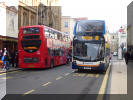
Congestion in High St Oxford with two bus stops placed side by side seen on
October 28th by Gavin Francis.
At the same time, the County Council has widened the
pavement at stop T1 in High Street with a two-metre buildout outside Lincoln
College Library. The intention is for the pavement to be wide enough to install
a bus shelter. But the result is that the carriageway is now too narrow for
buses to pass.
When a bus is at T1, eastbound buses behind it have to
swing out so far that they foul the westbound lane. Barely enough room is left
for a westbound cyclist to pass.
If there is traffic in the westbound lane, eastbound buses cannot pass a bus
stopped at T1. Even off-peak, the queue soon tails back as far as Carfax. At
busier times it can extend into St Aldate's. Now that Queen St has reopened, it
may extend there too.
The most frequent services at T1 are Arriva's 280 and Oxford Bus Companies
Brookes U1. Often both buses are there at the same time. This makes it even
harder for eastbound vehicles to get a gap in the westbound traffic long enough
to let them pass.
And T1 "blinds" the junction with Turl Street just as G1 blinds the junction
with Pembroke Square. If a bus is at T1, traffic emerging from Turl St to turn
right cannot see westbound traffic in High St. And now that the buildout blocks
the eastbound lane, road users from Turl St are much nearer a potential point of
impact before they can see past the bus to see if any vehicle is coming
westbound.
Much of Turl Street's traffic is cyclists. Turl St is the approved cycle bypass
for Cornmarket when cycling is forbidden (10am to 6pm daily).
Two things are needed. Firstly the County Council must recognise its mistake and
remove the buildout. And secondly it must take T1 out of use and relocate its
buses to other stops.
One way to do this is to restore one stop in Queen Street. The best place is
opposite M&S, where the temporary stop was recently for a few months. It is a
much better and safer place than the unsatisfactory stop D4 that used to be in
Bonn Square.
A new Queen St stop would allow at least one more eastbound route to be switched
from St Aldate's back to Queen St. This would liberate one of the St Aldate's
stops G2 – G6, which could then be served by routes currently using T1.
Chatham Road
For the reopening of the Westgate Centre the County Council has made several
traffic changes. One is to close a bus stop in Abingdon Road at the junction
with Chatham Road. It is the first northbound stop north of Weirs Lane.
The County Council claimed the closure would be only for the first few days of
the Westgate Centre's reopening, to cope with any exceptional traffic. Now it
has said the closure is permanent. This is, of course, a case of favouring cars
over buses. It is regressive.
Some Labour councillors have come to the support of passengers who use
the Chatham Road stop. But Labour supported the expansion of the Westgate
Centre, so as yet we are unsure how solid their support will be.
Castle Street and Speedwell Street
There are now 11 stops in Castle Street and two new stops in
Speedwell Street. All have new shelters, and all are inadequate. They have only
half-width end panels, which give too little protection to waiting passengers.
Given that much of the Westgate redevelopment had a "clean slate" to rearrange
streets and their furniture, there is no excuse. Our City and County councils
have willfully and unnecessarily ignored the DfT's Inclusive Mobility
guidelines, which include comprehensive specifications for optimal bus shelters.
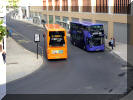
Westgate looking up Castle St with new stops seen on October 29th by Gavin
Francis.
The next battle may be the County Council trying again to expel the last
29 buses per hour from Queen Street. Or it may be some other anti-bus
policy dreamt up by councillors and their officers who are either anti-bus or at
best ignorant of what bus services need from a local council and how to be
pro-bus.
My many conversations with them in the last decade convince me that too many
councillors and officers are determined to remain ignorant. Bus passengers and
campaigners must expect the unexpected, and too often it will be a change for
the worse. The struggle continues!


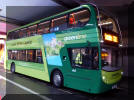
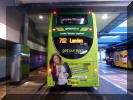
Reading 1208 in full Green Line livery on the 702 in Bulleid Way Victoria on
December 31st by Gavin Francis.
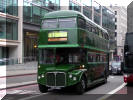
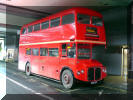
Two buses used on the Christmas Eve heritage services were also caught in the
lens of Gavin Francis.
RCL2260 looks very much the part, whilst RMC1462 is maybe not quite so
appropriate in the red livery.
http://www.reading-buses.co.uk/greenline/ will link you to the new services.
More developments by Reading were announced by
Slough Borough Council who confirmed it has contracted Reading Buses
to provide full bus services across routes 4,5 and 6 from 20 January 2018.
Following talks with bus operators and Heathrow the council has signed a
contract with Reading Buses that will guarantee residents and commuters
experience no break in service.
The council secured the contract by exercising its emergency powers to save
routes set to be cancelled or heavily cut back by First Berkshire. The contract
will be jointly funded by the council and Heathrow.
As of Saturday 20 January, Reading Buses, who will trade under
the ‘Thames Valley’ name in Slough, will provide the following
services:
●
Service 4 (Slough-Bath Road-Maidenhead)
●
Service 5 (Slough-Chalvey-Cippenham Green-Cippenham)
●
Service 6 (Slough-Wexham Park-Knolton Way)
Councillor Martin Carter, cabinet member for planning and transport, said:
“We are delighted to have secured Reading Buses
to provide unbroken services to residents and commuters across the borough in
the 2018. Reading Buses have been transporting customers in and around Reading
for more than 100 years and have a proven track record in providing quality bus
services with a strong focus on innovation and customer service. Many of our
residents and businesses rely on bus services on a daily basis to make their
journeys around Slough and to surrounding areas, including Heathrow. Our bus
users can now rest assured that their routes are secure, whether commuting to
Heathrow for work, or travelling to their local GP for a doctor’s appointment.”
Martijn Gilbert, Chief Executive Officer of Reading Buses, said:
“We are delighted to be bringing our award
winning approach to local bus service delivery to Slough. This builds upon our
recent work to take on the long-standing Green Line 702 London service from 27th
December and further supports the vision of the leading economic forums across
our region for strong and integrated local transport links across the Thames
Valley. We’re a local Berkshire based company with operations across four
Boroughs and Slough is a good adjacent fit with this. We look forward to serving
the people of Slough and working with the Borough Council and other stakeholders
to support and develop these important bus services."
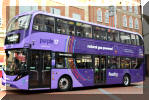
Reading 708 at the launch of new GAS buses on route 17 which took place on
January 14th pictured by Daryl Major.
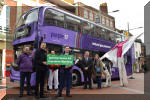
This picture shows a group of dignitaries at the launch. I won't even begin to
surmise why the cow was there!!! Did it have a fleet number?
![]()
In the weeks of December and January the weather was been much in evidence with roads closed or dangerous with heavy snow falls especially on the Chilterns in the second week of December. I received some delightful pictures of bus and coach services in this period and of course immediately after Christmas other parts of the country faced difficult operating conditions.
Sunday, December 10th saw probably and locally the worst conditions, when after heavy overnight snow, the morning proved very difficult indeed with few services to London, Heathrow, Gatwick or Stansted from Oxford and many local services not operating. A 7" fall of snow was recorded at Stokenchurch and the M40 was closed or only partially passable for much of the day.
The first pictures, which are by Gavin Francis, show the heavy snow conditions at Thornhill Park & Ride.

Snow at Thornhill - Oxford's nr. 6 outbound to LHR at 0924 on December 10th.
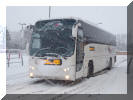
Snow at Thornhill - Oxford's 42 inbound from London at 0847 on December 10th.
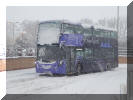
Snow at Thornhill - 678 SK66HVC r 400 at 0915 on December 10th.
The next pictures were taken by "Teng Leng" believed to be a coach driver in Oxford!!! They show conditions at Brookes and later services were curtailed for most of the day.
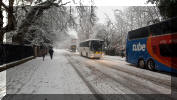
Snow at Brookes - heavy snow caused delays and cancellations - 1 seen on
December 10th by Teng Leng.

Snow at Brookes - heavy snow caused delays and cancellations - with 50265
inbound on December 10th by Teng Leng.
![]()
In High Wycombe following competition between Arriva and Carousel on the much heralded joint route between Wycombe and Chesham, which was divided into two separate services in September, peace has now returned and a "joint operation" will now resume.
![]()
Questions from a reader
1/ In the days when the Park & Ride services were
numbered 590-595, why did they often simply display 'Park & Ride' as the
destination?
2/In the days of the 580/581/582/583 how did the
different variations differ from each other? Also why was there A 260 and 280
but no 270?
3/ When COMS was privatized for deregulation which old
service numbers did they revert to? I know the 501 and 502 didn't revert to
their old numbers, as they were the 1 and 1A before, and then became the 51 and
52 after deregulation.
4/ Why, in days gone by, did busses often used to
give more precise destinations than they do now? For example the destination
shown on the 7A towards City Centre was Cornmarket & St Aldate's and the
destination shown on the 4 towards Rose Hill was Westbury Crescent?
5/ Why were Oxford Bus Company's 201, 203 and 5 services renumbered 101, 103 and
105 respectively?
6/ What were the route variations on Oxford Bus
Company's nr. 20 group of services?
I know that our readers questions will pose some thinking!
![]()
Oxford Bus replace older Levantes on the National Express 737 service
I am aware that there were some rumours that Levantes 51 and 52 were to be replaced. These coaches had come from Go Ahead in the North East and therefore had quite some mileage recorded.
Towards the end of November it was suggested that two new tri-axle Levantes on Volvo chassis were due. These appeared in early December but did not enter service until December 22nd when the first one was seen late on that day.
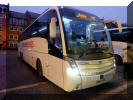
Gavin's picture shows 56 in the early evening of December 22nd at Gloucester
Green on its return from Stansted.
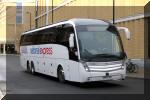
Graham Low's picture of 57 was taken on the following day on it's way to
Gloucester Green through the Westgate Centre.
The local enthusiasts then wondered what would happen to 51 and 52? This question was answered in the early days of 2018, when devoid of branding, they appeared on other Oxford coach routes to London and the airports.
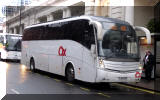
51 is seen in Gavin Francis's picture working the X90 on January 12th. It is
pictured on Buckingham Palace Road at the terminus of the X90.
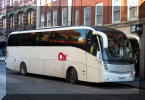
52 is seen turning out of Gloucester Green into George Street on its way to
Heathrow o January 7th taken by Gavin Francis.
Finally in this resume of Oxford Bus, two Hybrids from the last batch, 365 and 366, were repainted pale blue for the 2 road services. These replaced the original 2 road Scanias transferred to Thames Travel for the River Rapid services.
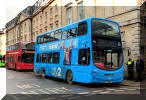
365 is seen in Magdalen Street East, on 2 road, fully branded. Pictured on
December 21st by Oxford Bus Company.
![]()
Use the menu on your left to view other content.